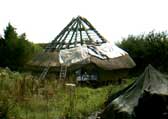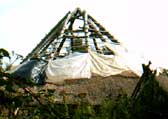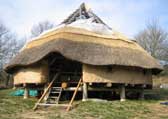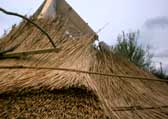New Roundhouse: Thatching
In order to thatch, the roof had to be covered in battens at 16 inch intervals. These were made from 2 inch thick coppiced hazel which were long enough to be fixed to one rafter, pass over another, and fix on to the next. Longer lengths are required at the bottom of the roof , and shorter ones towards the top. Although I have used twine lashings on previous occasions, we opted for screwing the battens down. This was primarily for security and longevity, but convenience did come into it.
The first course of thatch needs to have a roll of thatch under it to give it support. This is because every course thereafter rests on the one below. This roll is called a 'sausage' and needs to be 4 or 5 inches thick. It's made by feeding handfuls of reed into the loose end of a tied bundle, in order to increase it's length. Ties every 12 inches hold it together. Its length depends on how much distance of thatch you expect to lay that day.
Thatch can be laid in sections, (for example, 4 foot across and 4 courses high ) so that the Thatcher doesn't have to move his ladder so often, but I worked in concentric rings until I wearily reached the top. The first course gives the thatch it's thickness. The next course is the start of the roof proper, and needs to be 'dressed' so that it sits at the same angle as the roof. A tool called a 'leggat' is used to tap the bundles into shape. The top 2 inches of a course is left protruding out past the finished surface, and is only tapped into place with the course above it. This helps courses mesh together.
Two bundles are laid onto the battens. Their thick ends are where the eave is to be. Another length of hazel coppice, called a 'sway' is placed over them, and affixed on either side, to the batten underneath. The bundles are sandwiched between batten and sway. Cut the strings that bind the bundles, tidy the reeds, and tighten the sways. Repeat this process, laying each new bundle under the sways, and tightly next to it's secured neighbour. I used proper thatching fixings, which are screws with two lengths of stainless wire attached to them. The screw goes into the batten next to the bundle, and the wire is twisted around the sway.
Home | News
| First Roundhouse | New
Roundhouse |Gallery Index
The Project | Resources
| Contact | Help
All content: © The Roundhouse Project 1997-2010






